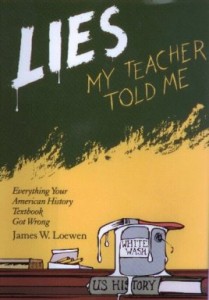This week’s open threads will highlight the historical inaccuracies that are present in history textbooks. Today I am going to focus on the Truth about the First Thanksgiving.
What your history teacher told you: The Pilgrims chose land around Plymouth Harbor for their settlement. Unfortunately, they had arrived in December and were not prepared for the New England winter. However, they were aided by friendly Indians, who gave them food and showed them how to grow corn. When warm weather came, the colonists planted, fished, hunted, and prepared themselves for the next winter. After harvesting their first crop, they and their Indian friends celebrated the first Thanksgiving.
The truth: The Thanksgiving myth is that the Pilgrims settled the United States in 1620. They had to fight off Indians repeatedly. During harsh winter the pilgrims didn’t know how to cultivate plants in the new soil so they dug up old bodies of the Indians they killed and ate them.
2. “Few Americans know that one-third of the United States, from San Francisco to Arkansas to Natchez to Florida, has been Spanish longer than it has been “American,” and that Hispanic Americans lived here before the first ancestor of the Daughters of the American Revolution ever left England” . British and French fisherman, landing in Massachusetts for fresh water and supplies in 1617, brought the plague to the American Indians. “Within three years the plague wiped out between 90 percent and 96 percent of the inhabitants of coastal New England… Unable to cope with so many corpses, the survivors abandoned their villages” .
3. What the Pilgrims found were settled farms, with the crops already planted and growing, deserted by Indians fleeing the plague. The Pilgrims “found it easy to infer that God was on their side. John Winthrop, governor of the Massachusetts Bay Colony, called the plague “Miraculous”” .
4. “These epidemics probably constituted the most important geopolitical event of the early seventeenth century. Their net result was that the British, for their first fifty years in New England, would face no real Indian challenge”
5. The plagues “continued west, racing in advance of the line of culture contact… Disease played the same crucial role in Mexico and Peru as it did in Massachusetts… When the Spanish marched into Tenochtitlan [now Mexico City], there were so many bodies [dead from the plague] that they had to walk on them” .
6. “..the population of the Americas [was] one hundred million in 1492.. Europe had only about seventy million people when Columbus set forth. The Europeans’ advantages in military and social technology might have enabled them to dominate the Americas.. but not to “settle” the hemisphere. For that, the plague was required” .
7. “.. the land was, in reality, not a virgin wilderness, but recently widowed” .
8. We also tend, in favor of the Pilgrims, to ignore Jamestown which was settled first. “Historians could hardly tout Virginia… The Virginians’ relations with the Indians were particularly unsavory…the early Virginians engaged in bickering, sloth, even cannibalism. They spent their early days digging random holes in the ground, haplessly looking for gold instead of planting crops. Soon they were starving and digging up putrid Indian corpses to eat or renting themselves out to Indian families as servants” .
9. “..the Pilgrims hardly “started from scratch” in a “wilderness.” Throughout southern New England, Native Americans had repeatedly burned the underbrush, creating a parklike environment… They chose Plymouth because of its beautiful cleared fields, recently planted in corn, and its useful harbor and “brook of fresh water.” It was a lovely site for a town. Indeed, until the plaque, it had been a town..” . One of the first things the Pilgrims did was go through the town, looting the possessions of the Indians. “..the Pilgrims continued to rob graves for years” .
10. “More than any other celebration.. Thanksgiving celebrates our ethnocentrism… God on our side, civilization wrested from wilderness, order from disorder, through hard work and good Pilgrim character traits” (93).

